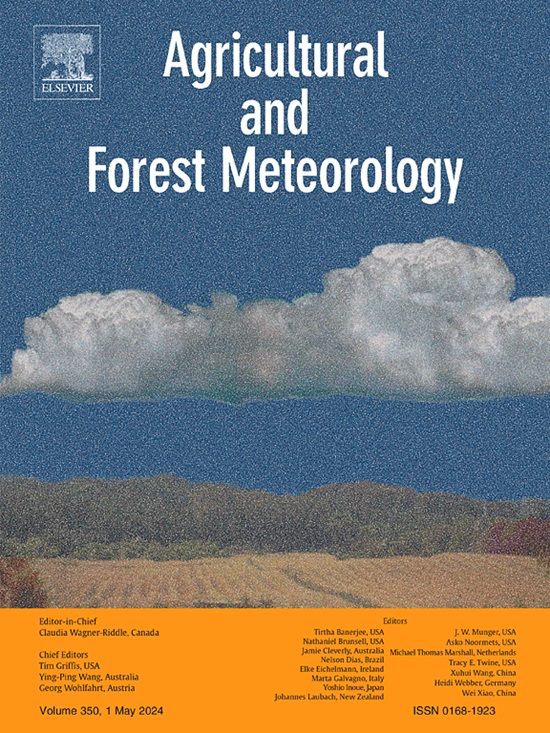苹果花期预测的PhenoFlex框架的跨区域验证:在德国和西班牙的研究
IF 5.7
1区 农林科学
Q1 AGRONOMY
引用次数: 0
摘要
模拟温带果树的休眠期对评估气候变化对树木物候和春霜事件的影响至关重要。虽然物候模型的品种参数化可以提供准确的预测,但它在物种水平上的前景有限。利用苹果物种的共享参数和特定品种参数可以改善物候预测,提供对未来风险的见解,并为温带果园适应气候变化的策略提供信息。在这项研究中,我们评估了PhenoFlex在用于估计来自德国和西班牙的苹果树的一组通用模型参数时的性能。我们使用了5个德国和11个西班牙品种的历史物候和天气数据,测试了两种校准方法:特定地点(按国家分组的数据)和特定物种(将所有16个品种的数据组合在一起),采用两种拟合程序:全球优化和增强的全球优化。总体而言,物种特异性校准提高了PhenoFlex模型的准确性,特别是在增强的全局优化下,西班牙品种(“Clara”的RMSE分别为4.6天和5.4天)。另一方面,德国品种的定位校准效果更好。增强的全局优化将最大误差从12.0天减少到7.5天(物种特定拟合中的“Collaos”),优于全局优化过程。冷热响应曲线分析揭示了不同校准方法的差异,物种特异性校准显示中等响应。我们的研究结果突出了物候模型中概括性和特异性之间的权衡。整合同一品种的多站点数据可以提高物种水平参数的可靠性,并为气候适应型果园管理提供信息。本文章由计算机程序翻译,如有差异,请以英文原文为准。


Cross-regional validation of the PhenoFlex framework for flowering date prediction in apple: A study across Germany and Spain
Modeling the dormancy period in temperate fruit trees is essential to assessing the impacts of climate change on tree phenology and spring frost events. Whereas cultivar-specific parametrization of phenology models may provide accurate predictions, it offers limited outlook at the species level. Using shared parameters for apple species alongside cultivar-specific parameters would improve phenology projections, provide insights into future risks, and inform strategies for adapting temperate orchards to climate change. In this study, we assessed the performance of PhenoFlex when used to estimate a common set of model parameters for apple trees from Germany and Spain. We used historical phenology and weather data for 5 German and 11 Spanish cultivars, testing two calibration approaches: location-specific (data grouped by country) and species-specific (combining data for all 16 cultivars), under two fitting procedures: a global optimization and an enhanced global optimization. Overall, species-specific calibration increased the PhenoFlex model accuracy, especially for the Spanish cultivars under the enhanced global optimization (RMSE of 4.6 vs. 5.4 days, respectively for ‘Clara’). On the other hand, location-specific calibration performed better for German cultivars. The enhanced global optimization reduced maximum errors from 12.0 to 7.5 days (‘Collaos’ in the species-specific fit), outperforming the global optimization procedure. Analysis of chill and heat response curves revealed variation across calibration approaches, with the species-specific calibration showing moderate responses. Our results highlight the trade-offs between generalizability and specificity in phenology modeling. Integrating multi-site data for the same cultivar could improve species-level parameter reliability and inform climate-resilient orchard management.
求助全文
通过发布文献求助,成功后即可免费获取论文全文。
去求助
来源期刊
CiteScore
10.30
自引率
9.70%
发文量
415
审稿时长
69 days
期刊介绍:
Agricultural and Forest Meteorology is an international journal for the publication of original articles and reviews on the inter-relationship between meteorology, agriculture, forestry, and natural ecosystems. Emphasis is on basic and applied scientific research relevant to practical problems in the field of plant and soil sciences, ecology and biogeochemistry as affected by weather as well as climate variability and change. Theoretical models should be tested against experimental data. Articles must appeal to an international audience. Special issues devoted to single topics are also published.
Typical topics include canopy micrometeorology (e.g. canopy radiation transfer, turbulence near the ground, evapotranspiration, energy balance, fluxes of trace gases), micrometeorological instrumentation (e.g., sensors for trace gases, flux measurement instruments, radiation measurement techniques), aerobiology (e.g. the dispersion of pollen, spores, insects and pesticides), biometeorology (e.g. the effect of weather and climate on plant distribution, crop yield, water-use efficiency, and plant phenology), forest-fire/weather interactions, and feedbacks from vegetation to weather and the climate system.

 求助内容:
求助内容: 应助结果提醒方式:
应助结果提醒方式:


